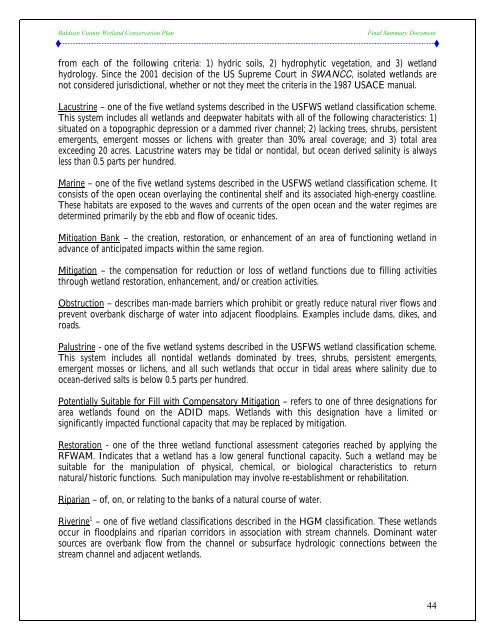Baldwin County Wetland Conservation Plan - Alabama Department ...
Baldwin County Wetland Conservation Plan - Alabama Department ...
Baldwin County Wetland Conservation Plan - Alabama Department ...
You also want an ePaper? Increase the reach of your titles
YUMPU automatically turns print PDFs into web optimized ePapers that Google loves.
<strong>Baldwin</strong> <strong>County</strong> <strong>Wetland</strong> <strong>Conservation</strong> <strong>Plan</strong> Final Summary Document<br />
from each of the following criteria: 1) hydric soils, 2) hydrophytic vegetation, and 3) wetland<br />
hydrology. Since the 2001 decision of the US Supreme Court in SWANCC, isolated wetlands are<br />
not considered jurisdictional, whether or not they meet the criteria in the 1987 USACE manual.<br />
Lacustrine – one of the five wetland systems described in the USFWS wetland classification scheme.<br />
This system includes all wetlands and deepwater habitats with all of the following characteristics: 1)<br />
situated on a topographic depression or a dammed river channel; 2) lacking trees, shrubs, persistent<br />
emergents, emergent mosses or lichens with greater than 30% areal coverage; and 3) total area<br />
exceeding 20 acres. Lacustrine waters may be tidal or nontidal, but ocean derived salinity is always<br />
less than 0.5 parts per hundred.<br />
Marine – one of the five wetland systems described in the USFWS wetland classification scheme. It<br />
consists of the open ocean overlaying the continental shelf and its associated high-energy coastline.<br />
These habitats are exposed to the waves and currents of the open ocean and the water regimes are<br />
determined primarily by the ebb and flow of oceanic tides.<br />
Mitigation Bank – the creation, restoration, or enhancement of an area of functioning wetland in<br />
advance of anticipated impacts within the same region.<br />
Mitigation – the compensation for reduction or loss of wetland functions due to filling activities<br />
through wetland restoration, enhancement, and/or creation activities.<br />
Obstruction – describes man-made barriers which prohibit or greatly reduce natural river flows and<br />
prevent overbank discharge of water into adjacent floodplains. Examples include dams, dikes, and<br />
roads.<br />
Palustrine - one of the five wetland systems described in the USFWS wetland classification scheme.<br />
This system includes all nontidal wetlands dominated by trees, shrubs, persistent emergents,<br />
emergent mosses or lichens, and all such wetlands that occur in tidal areas where salinity due to<br />
ocean-derived salts is below 0.5 parts per hundred.<br />
Potentially Suitable for Fill with Compensatory Mitigation – refers to one of three designations for<br />
area wetlands found on the ADID maps. <strong>Wetland</strong>s with this designation have a limited or<br />
significantly impacted functional capacity that may be replaced by mitigation.<br />
Restoration - one of the three wetland functional assessment categories reached by applying the<br />
RFWAM. Indicates that a wetland has a low general functional capacity. Such a wetland may be<br />
suitable for the manipulation of physical, chemical, or biological characteristics to return<br />
natural/historic functions. Such manipulation may involve re-establishment or rehabilitation.<br />
Riparian – of, on, or relating to the banks of a natural course of water.<br />
Riverine 1 – one of five wetland classifications described in the HGM classification. These wetlands<br />
occur in floodplains and riparian corridors in association with stream channels. Dominant water<br />
sources are overbank flow from the channel or subsurface hydrologic connections between the<br />
stream channel and adjacent wetlands.<br />
44

















